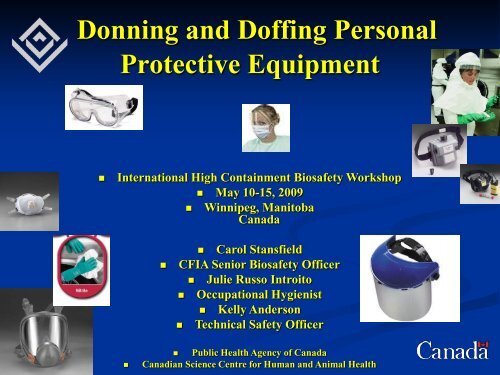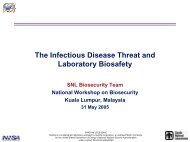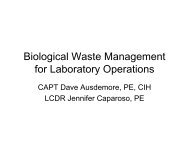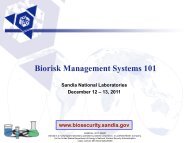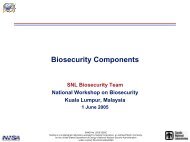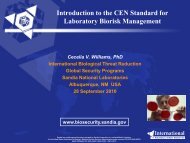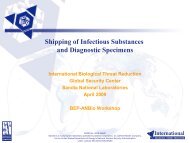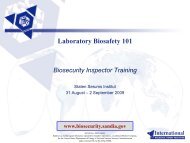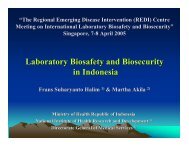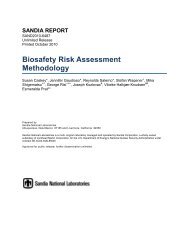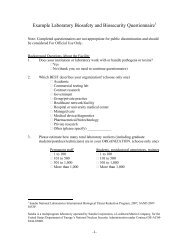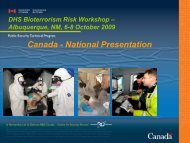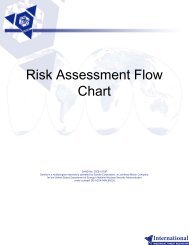Donning and Doffing Personal Protective Equipment
Donning and Doffing Personal Protective Equipment
Donning and Doffing Personal Protective Equipment
Create successful ePaper yourself
Turn your PDF publications into a flip-book with our unique Google optimized e-Paper software.
<strong>Donning</strong> <strong>and</strong> <strong>Doffing</strong> <strong>Personal</strong><strong>Protective</strong> <strong>Equipment</strong>• International High Containment Biosafety Workshop• May 10-15, 2009• Winnipeg, ManitobaCanada• Carol Stansfield• CFIA Senior Biosafety Officer• Julie Russo Introito• Occupational Hygienist• Kelly Anderson• Technical Safety Officer• Public Health Agency of Canada• Canadian Science Centre for Human <strong>and</strong> Animal Health
ObjectivesDifferent types of <strong>Personal</strong> <strong>Protective</strong><strong>Equipment</strong>:• Selection• Use & Limitations• <strong>Donning</strong> / <strong>Doffing</strong>• User Seal Checks• Common Applications
Introduction• Hazards exist in many forms•Particulates•Gas/Vapour
Forms Of ContaminantsPARTICULATESDustGAS / VAPOURGasMistFumeFibreVapour
Controlling of Hazards•Engineering controls•Work practice controls•Elimination or substitution•<strong>Personal</strong> protective equipment<strong>Personal</strong> protective equipment last resort(PPE)
<strong>Personal</strong> <strong>Protective</strong> <strong>Equipment</strong>• Hazard Assessment• Requirement for PPE• Selecting the PPE• Training Employees in Proper Useof PPE
<strong>Personal</strong> <strong>Protective</strong> <strong>Equipment</strong>H<strong>and</strong>s Respiratory System Skin Eyes EngineeringControlsGlovesNitrileVinylNeopreneCut ResistantOther_______N100 RespiratorHalf Face Respirator-Particulate Filters-Chemical Cartridges-List Type______________Full Face Respirator-Particulate Filters-Chemical Cartridges-List Type______________PAPR-Particulate Filters-Chemical Cartridges-List Type______________Self Contained BreathingApparatus (SCBA)Other__________________Lab CoatSurgical GownShoe CoversHair CapsCoverallsScrubsTyvek SuitOther________Chemical SafetyGlassesChemical GogglesFace ShieldOther________Biosafety Cabinet Used:At All TimesOnly SometimesExplain_______________Type of Biosafety Cabinet Used:Class II B2(total exhaust)Class IIA/B3(thimbleconnection)Class IIA/B3(recirculated air)Glove Box
Potential For Exposure to BiologicalsName ofBiohazardor GroupofBiohazardsType ofBiohazardForm ofBiohazard[ ] Known Routes ofExposureKnownInfectiveDose ofBiohazardHow is theBiohazardH<strong>and</strong>ledin the LabHow frequentlyis theBiohazardH<strong>and</strong>ledQuantity ofBiohazardH<strong>and</strong>led atOne TimeBacteriaVirusPrionHumanPathogenAnimalPathogen-Non-ZoonoticAnimalPathogen-ZoonoticOtherCulture, liveFrozenLyophilizedFixedDNARNARecombinant DNARecombinant RNADiagnosticSamplesBloodSerumSputumFecesCFSTissue(type)Environmental SourceOtherContact withMucousMembers/EyesInhalation ofAerosolsIngestionContact withnon- intact skinParenteralInoculationOtherPipettedH<strong>and</strong>ledwithSharpsCentrifugedPouredInoculated withLoopUsed toprepareslidesCulturesGrownInfectedAnimalOther>5 times/day2-4 times/dayonce dailyup to 4times/week1 time/week2-3 times/monthmonthly2-4 times/year5-11 times/yearless than once ayearotherul/g quantities>1ml/g1ml/g-100ml/g100ml/g-1000ml/g
<strong>Personal</strong> <strong>Protective</strong> <strong>Equipment</strong>• Gloves• Gowns, Tyvek Suits, Coveralls• Shoe <strong>and</strong> Head Covers• Masks <strong>and</strong> Respirators• Other Face <strong>and</strong> Eye Protection
How to select your PPE• Means of transmission• Type of exposure
Major Routes Of EntryInhalationIngestionAbsorptionPuncture
Sizes of Selected ParticlesVisible by electronmicroscopeVisible bymicroscopeVisible by human eyeVirusesWelding fumeTobacco smokeBacteriaIndustrial mistsPollenHumanhairDustFogMists &drizzleRain0.010.11.010Particle diameter - micronsTotal Inhalable100100010000(1mm = 1,000 microns)
Selecting PPE• Safe design <strong>and</strong> construction• Maintained in a clean <strong>and</strong> reliablefashion• Fit <strong>and</strong> comfort should be considered• Several different type of PPE worntogether, make sure they arecompatibleSome PPE have st<strong>and</strong>ards that need to be followed.
Training Employees• In proper use of PPE• When PPE is necessary.• What PPE is necessary.• How to properly put on, take off, adjust<strong>and</strong> wear the PPE.• The limitations of the PPE.• Proper care, maintenance, useful life <strong>and</strong>disposal of PPE.
Gloves• Gloves help protect you when directly h<strong>and</strong>ling potentiallyinfectious materials or contaminated surfaces.• Wear gloves when directly h<strong>and</strong>ling potentially infectiousmaterials or in contact with contaminated surfaces.• Vinyl, latex, or nitrile gloves may be worn. (there aremany other types of gloves other than the ones listed here)• Change gloves when visibly soiled, torn or punctured.• Wash h<strong>and</strong>s upon removing gloves. Gloves do not replacethe need for excellent h<strong>and</strong> washing!• http://www.bestglove.com
Gloves• Purpose is to protect from infectiousagents/chemicals beingtransmitted/absorbed via h<strong>and</strong>s• Body fluids, mucous membranes non-intactskin• Contaminated equipment <strong>and</strong> surfaces• Considerations• Fit (tight fitting or loose fitting)• Material• Sterile, non sterile• Use <strong>and</strong> reuse, disposable versus reusable
Types of <strong>Protective</strong> Gloves• Type of chemicals h<strong>and</strong>led.• Nature of contact (total immersion, splash, etc.).• Duration of contact.• Area requiring protection (h<strong>and</strong> only, forearm, arm).• Grip requirements (dry, wet, oily).• Thermal protection.• Size <strong>and</strong> comfort.• Abrasion/resistance requirements.• Gloves made from a wide variety of materials are designedfor many types of workplace hazards. In general, glovesfall into four groups:• Insulating rubber gloves (See 29 CFR 1910.137 <strong>and</strong> the followingsection on electrical protective equipment for detailed requirementson the selection, use <strong>and</strong> care of insulating rubber gloves).• Gloves made of leather, canvas or metal mesh;• Fabric <strong>and</strong> coated fabric gloves;• Chemical- <strong>and</strong> liquid-resistant gloves;
Limitations of PPE(gloves)• Gloves:• Prone to holes <strong>and</strong> tears even before theiruse• Glove materials can degrade over time/extendedwear• Protects against visible/gross contamination butdoesn’t provide a perfect seal against allcontamination
Gowns• Gowns help protect you from the contamination ofclothing with potentially infectious material.• Wear a gown when contamination of clothingwith potentially infectious material is possible.• Your gown should fully cover the torso, fitclose to the body <strong>and</strong> cover the arms to the wrists.• Choose a gown appropriate to the situation:• Disposable vs re-useable (requires laundering).• Fluid-resistant vs non fluid-resistant.• Sterile vs clean.
O.R. Gown Full Barrier Front• raised neckb<strong>and</strong>, colour coded to identify size• GORE® LP Surgical Fabric protection on gownfront <strong>and</strong> on sleeves from 4" above elbow toknitted cuff <strong>and</strong> yolk to hem• three sets of inside centre back tape ties• overlap back for better coverage• outside tie closure at waist• seam sealed sleeves•Scrubs
Tyvek Suits, Coveralls• Protect your skin <strong>and</strong> clothingwhen working with dirt, paint,solvents, chemicals, oil, grease.These multipurpose suits aredurable <strong>and</strong> can be worn over<strong>and</strong> over.Head <strong>and</strong> body protection in adisposable coverall withelasticized cuffs to protect arms<strong>and</strong> legs.The durable Tyvek® fabric ishard to tear or puncture, yet itfunctions as a breathablemembrane that allows bodyheat <strong>and</strong> sweat to escape whilepreventing chemicals, paints<strong>and</strong> particles from getting in.•(There are many other types of coveralls made of cloth, heavy PVC/Poly, etc…..)
Limitations of PPE(gowns <strong>and</strong> tyvek suits)• Gowns• Gowns that are fluid-permeable can become saturated/ wetover time• Tyvek suits• The garment is not suitable for use in all situations <strong>and</strong>environments with all chemicals <strong>and</strong> hazardous materials.(you must consider when choosing protective clothing the permeation, degradation <strong>and</strong>penetration of the material with respect to the chemical you are trying to protect against)The decision regarding the choice of chemical protective clothing must be madeby trained <strong>and</strong> qualified safety professionals.
Shoe <strong>and</strong> Head Covers• Shoe covers• Wear shoe covers to provide a barrier againstpossible exposure to airborne organisms orcontact with a contaminated environment.• Head covers• Wear head covers to protect the hair <strong>and</strong>scalp from possible contamination whensprays or airborne exposure is anticipated.
Limitations of PPE(shoe covers <strong>and</strong> head cover)• Shoe covers• Must be slip resistant or made of anti-slip materials<strong>and</strong> still may not be adequate for certain tasks• Head Covers• Can become wet/ saturated over time
Masks <strong>and</strong> Respirators• Surgical masks help protect your nose <strong>and</strong>mouth from splattered body fluids(such asblood, respiratory secretions, vomit, urineor feces).(a surgical mask is not a respirator)• Respirators filter the air before you inhaleit.
Respirators• Respirators filter the air you breathe to helpprotect you from microorganisms includingbacteria <strong>and</strong> many viruses.• Types of respirators include:• Disposable Respirators (includes N95, N100)• Air Purifying Respirators• Powered Air Purifying Respirator (PAPR)• Self-Contained Breathing Apparatus (SCBA)Respirators
Air Purifying Respirators• Non-powered ( Negative Pressure )• Powered ( Positive Pressure or PAPR )Air-Mate TM HEPAPAPR SystemR-Series TMPAPR System
Negative Pressure Air Purifying RespiratorHOW IT WORKSBy inhaling, a negative pressure is createdin the respirator. Ambient air flowsthrough a filter or cartridge, whichremoves the contaminants. The clean aircontinues into the respirator <strong>and</strong> then thelungs.ParticleFilterGas/VapourMedia
Positive Pressure Air Purifying Respirator(A.K.A. Powered Air Purifying Respirators (PAPRs))The motor/blower unit pulls the ambient airthrough a filter or cartridge, which removesthe contaminants, <strong>and</strong> then forces thepurified air into the breathing zone.Motor/BlowerFilterGas/VapourMedia
Fit Testing MethodsQUALITATIVE:Subjective pass/fail method.Sensory response of the testsubject to a test agent.QUANTITATIVE:Objective test.Number generated.
Factors Affecting Face Seal• Facial hair• Weight loss/gain• Wrinkles, scars, acne, make-up• Facial structure• Dentures
NIOSH Particulate FilterClassifications• N-Series: Not for oil• Approved for non-oil particulate contaminants• Use until increased breathing resistance or damaged(In Health Care settings, the infection controlpractices take precedence)• R-Series: Resistant to oil• Approved for all particulate contaminants• Time restriction of 8 hours when oils are present• P-Series: Oil Proof• Approved for all particulate contaminants• Manufacturer’s time use restrictions apply
NIOSH Particulate FilterClassifications
Limitations of Air PurifyingRespirators• Not for use in atmospheres containing less than 19.5%oxygen• Not for use in Immediately Dangerous to Life <strong>and</strong>Health (IDLH) atmospheres• Not for use when concentration exceeds AssignedProtection Factor (APF) X Exposure Limit• Do not use with facial hair, or other conditions thatinterfere with the seal between the face <strong>and</strong> therespirator (N100, ½ or full face tight fitting respirator)• Do not alter, abuse, or misuse the respirator
Limitations of PPE (respirators)• Respirators:•Difficult to wear over long periods oftime•Materials can degrade <strong>and</strong> lose theirprotective properties over time•The effectiveness of the respirator ishighly dependent on the user fit
Respiratory <strong>Protective</strong> <strong>Equipment</strong> SpectrumSurgicalMaskHalfFacepiece,FilteringFacepieceorMaintenance-FreeFull-faceRespiratorPowered-AirPurifyingRespiratorAir-LineSelf-ContainedBreathingApparatusProtection
Eye <strong>and</strong> Face Protection-Safety spectacles-Goggles-Welding shields-Laser safety goggles-Face shields
Eye <strong>and</strong> Face Protection• Goggles help protect only your eyes fromsplatters.• A face shield provides splatter protection tofacial skin, eyes, nose, <strong>and</strong> mouth.
Goggles• Goggles are a barrier style of protection forthe eyes.• Goggles should fit snuggly over <strong>and</strong> aroundthe eyes or prescriptive lenses.• Note: prescriptive lenses <strong>and</strong>/or safetyglasses do not provide adequate eyeprotection.
Goggles• 3 types of goggles• Direct vented goggles -allow a direct flow of air from the workenvironment into the goggles. Used for cases where impact is thehazard, not for splash or vapour hazards• Indirect vented goggles – provide protection from splash entryby a “hooded” or covered vent that allows the free movement of air butprevents the direct passage of liquid. Used in cases where chemicalsplash is the hazard. (limit or prevent the passage of liquid splash intothe goggles)• Non-vented goggles – will have no venting of any kind <strong>and</strong> offerprotection against the passage of dust, mist, liquid <strong>and</strong> vapours. Usedfor cases where chemical vapour is the hazard
Face Shields• Face shields protect the mucous membranes of theeyes, nose <strong>and</strong> mouth from splashes of body fluids(during procedures <strong>and</strong> patient care activities thatare likely to generate splashes or sprays of blood,body fluids, secretions <strong>and</strong>/or excretions).• Wear a face shield when facial skin protection isneeded in addition to eye, nose <strong>and</strong> mouthprotection.• A face shield may be worn with an N95 or N100respirator.• The face shield should cover the forehead, extendbelow the chin <strong>and</strong> wrap around the side of theface.
Limitations of PPE(eye <strong>and</strong> face protection)• Safety glasses - used mainly to protect the eyes from injury, flyingobjects such as large chips, fragments, particles, s<strong>and</strong> <strong>and</strong> dirt.• Goggles – used to protect the eyes from impact, splash <strong>and</strong> vapourhazards. Available non-vented or with direct or indirect vents. The nonventedgoggles may fog up during use <strong>and</strong> the indirect vented limit orprevent the passage of liquid splash into the goggles (not 100% proof).• Faceshield - A supplementary protective device worn to shield thewearer’s face from certain hazards. Face shields are secondary protectorsonly <strong>and</strong> must be worn with safety glasses or goggles, as stated in ANSIZ87.1.
<strong>Donning</strong> an N100 Respirator• Place therespirator overyour nose <strong>and</strong>mouth. Be surethe metal noseclip is on the top
<strong>Donning</strong> an N100 Respirator• Pull the bottomstrap over yourhead until it restsbelow the ears atthe back of yourneck. Untwist thestrap
<strong>Donning</strong> an N100 Respirator• Pull the top strapover your headuntil it rests onthe crown of yourhead above yourears. Untwist thestrap
<strong>Donning</strong> an N100 Respirator• Without removing therespirator, adjust thestraps until therespirator is secure. Totighten the respirator,gently pull the ends ofboth straps. To loosenthe respirator, presson the back side of thebuckle.
<strong>Donning</strong> an N100 Respirator• Using both h<strong>and</strong>s,starting at the top,mould the metal noseclip around your noseto achieve a secureseal. Note: Pinchingthe nosepiece usingone h<strong>and</strong> may result inimproper fit <strong>and</strong> lesseffective respiratorperformance. Use twoh<strong>and</strong>s.
Check the seal of your adjustable filteringfacepiece respirator each time you don therespirator• Place both h<strong>and</strong>s over therespirator <strong>and</strong> inhalesharply. The respiratorshould collapse slightly. Ifair leaks between the face<strong>and</strong> faceseal of therespirator, reposition it<strong>and</strong> adjust the nose clipfor a more secure seal. Ifyou cannot achieve aproper seal, do not enterthe contaminated area. Seeyour supervisor.
<strong>Doffing</strong> an N100 Respirator• Cup the respirator inyour h<strong>and</strong> to maintainposition on your face.
<strong>Doffing</strong> an N100 Respirator• Still holdingrespirator inposition, pull topstrap over headfirst, followed bythe bottom strap.
<strong>Doffing</strong> an N100 Respirator• Removerespirator fromface <strong>and</strong> storeaccording tofacility policy.Wash h<strong>and</strong>s.
DONNING PPE• 1• 2• 3• 4• 5• 6• 7• 8Change into ScrubsPut on Head CoverDon respiratory protectionPut on safety glasses, goggles or face shieldPut on first pair of glovesPut on gown or coveralls or apron if necessaryPut on second pair of glovesPut on Shoe Cover
Change from your regularclothes to scrubs
Put on Hair Cover
Remove any eyewear or jewellerythat could affect the respirator fit.
<strong>Donning</strong> RespiratorRefer to Respirator donning h<strong>and</strong>out.Prescription eyeglasses can be redonnedonce respirator seal check iscompleted
Putting on Eye protection, SafetyGlasses Goggles or Face Shield
Putting on 1 st Pair of gloves
<strong>Donning</strong> Fluid Resistant Gown
Putting on Second Pair of Gloves
Putting on Shoe Covers
PPE <strong>Doffing</strong> ProcedureRemoving 1 st pair of gloves
Remove gown <strong>and</strong> place in laundryhamper or dispose
Based on your Protocols <strong>and</strong>what you are working with:• You could remove the second pairof gloves after removing the fluidresistant gown.• Or• You can remove your second pairof gloves after you have removedall your PPE
Remove 2 nd pair of gloves
Remove eye protection <strong>and</strong> clean with adisinfectant asrequired by your facility
Remove eye glasses prior todoffing respirator
Remove Respirator
Remove Hair Cover
Remove Shoe Covers
Wash H<strong>and</strong>s
Wash H<strong>and</strong>s Often• Cleaning your h<strong>and</strong>sgets rid of germs youpick up from otherpeople . . . from thesurfaces you touch . . .<strong>and</strong> from the animalsyou come in contactwith.
H<strong>and</strong> Washing1. Wet h<strong>and</strong>s 2. Use liquid Soap 3. Lather, rub & count to 204. Rinse 5. Towel or air dry h<strong>and</strong>s 6. Turn off taps with towelor your sleeve
• Note: Any mention of trade namesis for identification purposes only<strong>and</strong> is not intended as anendorsement.
Any Questions?


